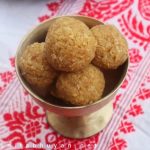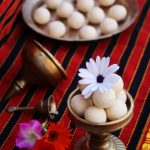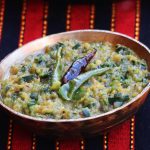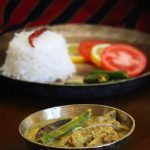Narikolor sira l Assamese style candied coconut with cardamom and saffron is usually made during Bihu, The major festival of Assam ( a state in the North eastern part of India). There are three types of Bihu, and one of them (Magh / Bhogali ) is coming up soon; so sharing this recipe in case someone wants to recreate it for the occasion.

Bihu?
Assam, a North Eastern state of India, is primarily agricultural and three of its major festivals are all centred around it. Bihu is celebrated by all Assamese irrespective of religion, caste and creed. It has three forms-
- Kati or Kongali Bihu (which is observed in October, to pray for a good harvest)
- Magh or Bhogali Bihu (observed in January, to celebrate the end of the harvesting season)
- Bohag or Rongali Bihu (observed in April, the start of the cultivation season and to usher in spring and the Assamese New Year)

Magh or Bhogali Bihu marks the end of the harvesting season. The granaries are full and there is a lot of feasting. Various rice and coconut based traditional snacks are prepared during this Bihu.
As coconuts are readily available in Assam, a lot of the snacks prepared during Magh Bihu has coconuts in some form. This narikolor sira is one of them. ‘Narikol’ refers to coconut and ‘sira’ refers to flaked rice. Sira is white in colour and the narikolor sira looks very similar to it, hence its name. However, the one I made has a slight orangish hue due to the saffron infused in it.

Patience-
The narikolor sira is not hard to make but does need some patience. It needs to be cooked over low heat and stirred constantly in order to avoid browning. The mark of some well made narikolor sira is the perfect white (in my case, with the slight orangish hue) with no brown bits. From the moment the pan was placed over heat, it took me approximately 20 minutes to cook it.
Coconut-
I used readymade shredded coconut from the frozen section of our local Asian grocery store, which made life much easier. If you do not have access to it, you can, of course make it the regular way- by grating the fresh coconut. Just don’t forget to peel it before grating and use only the white part. Also use the side of the grater with bigger holes.

The coconut mixture-
Before adding everything to the pan and cooking, mix all the ingredients together well.
Saffron-
Traditionally, saffron is not added to narikolor sira and it is usually pristine white. However, I love the flavour and hue of saffron and I added some to this narikolor sira; hence the slight orangish tint. If you do not prefer saffron, you can omit it in the recipe. But, I do highly recommend it.
Cooking pan-
It is recommended to use a heavy bottomed pan to cook the coconut mixture. I used a heavy, thick bottomed non stick pan.
Adding the mixture to the pan-
Always add the coconut mixture to the pan and then place it over heat for cooking. Do not heat the pan and add the mixture to it.
Cooking the coconut mixture-
The mixture needs constant attention; so don’t be tempted to leave it on the pan and disappear. The mark of good narikolor sira is one with no brown bits.
Checking readiness-
The narikolor sira is done when all the moisture is evaporated, and it is no longer a sticky mass. It will be dry and all the individual strands of coconut will also be separate from one another. Once the coconut is dry, remove from heat immediately and do not cook further, or it will brown. Transfer to a dish to cool, do not leave it in the pan.
Storing-
Make sure the narikolor sira is cooled completely before storing in air tight containers.

Continue reading for the full recipe for the narikolor sira l Assamese style candied coconut with cardamom and saffron.
All the Assamese recipes on this website can be found here.
You might also like to try the following recipes from this website-



Subscribe to Sunita’s World – life and food! to receive updates on latest posts, tips and recommendations straight to your inbox! Simply fill in the details below. Thank you!
Stay connected-
On another note, if you try any recipe from this website, do take a photo and tag me on instagram @sunita_bhuyan. I would love to see your creations! Also, do connect on other socials too; links to all my socials are given below-
STAY CONNECTED:Recipe card-

Narikolor sira l Assamese style candied coconut with cardamom and saffron
Ingredients
- 4 cups shredded coconut (see notes below)
- 1¼ cup caster sugar
- 1 tsp ground cardamom seeds
- a large pinch of saffron
Instructions
- Add all the ingredients to a bowl and mix well.
- Transfer the mixture to a thick bottomed pan ( I used a non stick pan).- see notes below
- Place the pan over low to medium heat and stir constantly for about 6-7 minutes (see notes below). The mixture will leave a lot of moisture and will be sticky.
- Reduce the heat to low and continue stirring for another 10-12 minutes or till all the moisture is absorbed and the mixture is dry. The coconut strands will not stick to each other and will be completely separate.
- Remove from heat and transfer immediately to a dish; do not leave it in the pan, or else it will brown.
- Cool completely before storing in air tight containers.
Video
Notes
Coconut-
I used readymade shredded coconut from the frozen section of our local Asian grocery store, which made life much easier. If you do not have access to it, you can, of course make it the regular way- grating the fresh coconut. Just don’t forget to peel it before grating and use only the white part. Also use the side of the grater with bigger holes.Adding the mixture to the pan-
Always add the coconut mixture to the pan and then place it over heat for cooking. Do not heat the pan and add the mixture to it.Cooking the coconut mixture-
The mixture needs constant attention; so don’t be tempted to leave it on the pan and disappear. The mark of good narikolor sira is one with no brown bits.You might also like to try the following recipes from this website-



Until next time,
Sunita
STAY CONNECTED:
